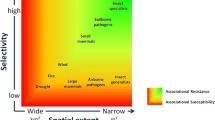Abstract
Restoring natural forests after field abandonment is a land management objective that fosters the recovery of forest biodiversity. We performed seeding and transplanting of native tree species 40 years after the abandonment of an arable field that became dominated by a dwarf bamboo (Pleioblastus chino (Franch. et Sav.) Makino) and by kudzu (Pueraria lobata (Willd.) Ohwi). By permutation tests, the removal of competing vegetation (gap creation) significantly increased the survival of three seeded species of Fagaceae and of eight transplanted species. In contrast, intact vegetation prevented most individuals of all species from surviving for 1 year after planting. The lack of natural recruitment of Fagaceae in the nonseeded subplots indicated that seed limitation was a cause of the slow afforestation. Although litter accumulation in gaps at the time of seeding slightly increased survival for late-germinating Quercus myrsinifolia Blume and Castanopsis sieboldii (Makino) Hatus. ex T. Yamaz. et Mashiba, the effect was not consistent among plots and was not statistically significant. Our results suggest that for successful afforestation using native trees in abandoned fields, it will be necessary to remove competitive native species to avoid severe limitations on microsite availability and that simultaneous tree establishment by seeding or transplanting should be implemented to accelerate the establishment of native tree species.



Similar content being viewed by others
References
Arita H, Ohkuro T (2007) A maintenance system aimed to control wood vegetation of abandoned paddy field—study based on a survey of Ohshima-are Jouetsu-shi Niigata, Japan. Trans Jpn Soc Irrig Drain Rural Eng 249:255–260 (In Japanese with English summary)
Baeten L, Hermy M, Daele SV, Verheyen K (2010) Unexpected understorey community development after 30 years in ancient and post-agricultural forests. J Ecol 98:1447–1453
Braun-Blanquet J (1932) Plant sociology (Transl G.D. Fuller and H.S Conrad). McGraw-Hill, New York
Cramer VA, Hobbs RJ, Standish RJ (2008) What’s new about old fields? Land abandonment and ecosystem assembly. Trends Ecol Evol 23:104–112
De Steven D (1991) Experiments on mechanisms of tree establishment in old-field succession: seedling emergence. Ecology 72:1066–1075
Economic Planning Agency. 1973. Ibaraki-Ken Dojou Bunruizu [Soil Classification Map of Ibaraki Prefecture]. Economic Planning Agency, Tokyo. (In Japanese)
Firth D (1993) Bias reduction of maximum likelihood estimates. Biometrika 80:27–38
Flinn KM, Vellend M (2005) Recovery of forest plant communities in post-agricultural landscapes. Front Ecol Environ 3:243–250
Hobbs RJ, Walker LR (2007) Old field succession: development of concepts. In: Cramer VA, Hobbs RJ (eds) Old fields. Island Press, Washington, DC, pp 17–30
Ida H, Nakagoshi N (1996) Gnawing damage by rodents to the seedlings of Fagus crenata and Quercus mongolica var. grosseserrata in a temperate Sasa grassland–deciduous forest series in southwestern Japan. Ecol Res 11:97–103
Iida S (2004) Indirect negative influence of dwarf bamboo on survival of Quercus acorn by hoarding behavior of wood mice. For Ecol Manag 202:257–263
Itô H, Hino T (2005) How do deer affect tree seedlings on a dwarf bamboo-dominated forest floor? Ecol Res 20:121–128
Itô H, Hino T (2007) Dwarf bamboo as an ecological filter for forest regeneration. Ecol Res 22:706–711
Legendre P, Legendre L (1998) Numerical Ecology, 2nd English edn. Elsevier, Amsterdam
Löf M, Welander NT (2004) Influence of herbaceous competitors on early growth in direct seeded Fagus sylvatica L. and Quercus robur L. Ann For Sci 61:781–788
Ministry of Agriculture, Forestry and Fisheries (2011) Census of agriculture and forestry. Ministry of Agriculture, Forestry and Fisheries, Tokyo. http://www.maff.go.jp/j/nousin/tikei/houkiti/pdf/genjou_1103r.pdf. Accessed 08 Nov 2013 (in Japanese)
Mitich LW (2000) Kudzu [Pueraria lobata (Willd.) Ohwi]. Weed Technol 14:231–235
Myster RW, Pickett STA (1993) Effects of litter, distance, density and vegetation patch type on postdispersal tree seed predation in old fields. Oikos 66:381–388
R Development Core Team (2013) R: a language and environment for statistical computing. R Foundation for Statistical Computing, Vienna
Rejmánek M, Van Katwyk KP (2004) Old-field succession: a bibliographic review (1901–1991). http://botanika.bf.jcu.cz/suspa/
Sato T, Nakata M (2008) Factors affecting forest formation in abandoned terraced paddy fields in a mountainous region. J Jpn For Soc 90:364–371 (In Japanese with English summary)
Sitzia T, Semenzato P, Trentanovi G (2010) Natural reforestation is changing spatial patterns of rural mountain and hill landscapes: a global overview. For Ecol Manag 259:1354–1362
Tokuoka Y, Ohigashi K, Nakagoshi N (2011) Limitations on tree seedling establishment across ecotones between abandoned fields and adjacent broad-leaved forests in eastern Japan. Plant Ecol 212:923–944
Wada N (1993) Dwarf bamboos affect the regeneration of zoochorous trees by providing habitats to acorn-feeding rodents. Oecologia 94:403–407
Zhang KR, Dang HS, Tan SD, Wang ZX, Zhang QF (2010) Vegetation community and soil characteristics of abandoned agricultural land and pine plantation in the Qinling Mountains, China. For Ecol Manag 259:2036–2047
Acknowledgments
We thank Mr. Toshio Mihashi and his family for approving our experimental use of their field. We thank Dr. Syuntaro Hiradate, Mr. Koukichi Matsumoto, Mr. Katsuo Abe, Mr. Hiroyuki Iino, Mr. Terushi Kamada, and other members of the experimental farm management division of the National Institute for Agro-Environmental Sciences, who helped to prepare the seedlings and assisted in vegetation management in the field.
Author information
Authors and Affiliations
Corresponding author
Additional information
The online version is available at http://www.springerlink.com
Corresponding editor: Yu Lei
Appendix
Appendix
See Table 3.
Rights and permissions
About this article
Cite this article
Tokuoka, Y., Ohigashi, K., Watanabe, K. et al. Removal of competitive native species combined with tree planting can accelerate the initial afforestation process: an experiment in an old field in Japan invaded by dwarf bamboo and kudzu. J. For. Res. 26, 581–588 (2015). https://doi.org/10.1007/s11676-015-0072-6
Received:
Accepted:
Published:
Issue Date:
DOI: https://doi.org/10.1007/s11676-015-0072-6




